Our route follows the central coastline from the province of Manabi to the province of Esmeraldes.
The following observations were made during a road trip on the mid to upper Pacific coastline of Ecuador from April 19 to April 22, 2016, by Christopher Breen and Michael Stephens. The purpose of the trip was to make objective and realistic observations of the damage caused by the 7.8 magnitude earthquake, whose epicentre was on the northern coast of Ecuador, close to the town of Muisne, in the north west province of Esmeraldes.
Neither of the two parties contributing these comments have experience in disaster relief, structural engineering or medical backgrounds. We both set off on this trip with the idea of being able to a; report with photographs, b; help online with reports of missing friends and family, c; road conditions, d; report on cell phone connections, e; the extent of the damage, f; the areas affected and g; the real time contribution that local, national and international organizations were currently involved with. At the time of departure, news was severely lacking.
At the beginning of our journey the estimated death toll on April 19, just 3 days after the quake, was around 250, with 750 additionally injured.
We both set off on the trip with sufficient tents, food, water, tools, medical supplies and gasoline to make the entire 2000km plus journey without relying on local supplies in the affected areas and with enough surplus to give away where needed.
We had questioned the idea of starting the trip after many rumors surfacing on social media had pointed to local robberies of donations and possible restrictions by the military or police, with roadblocks turning away unregistered travellers. There were also many unconfirmed reports that due to the state of the road networks access was almost impossible. We had also seen reports that bus services from Guayaquil to the Manta area had been withdrawn due to a lack of gasoline. We were able to prove during these 4 days of travel that most of these reports were unfounded.
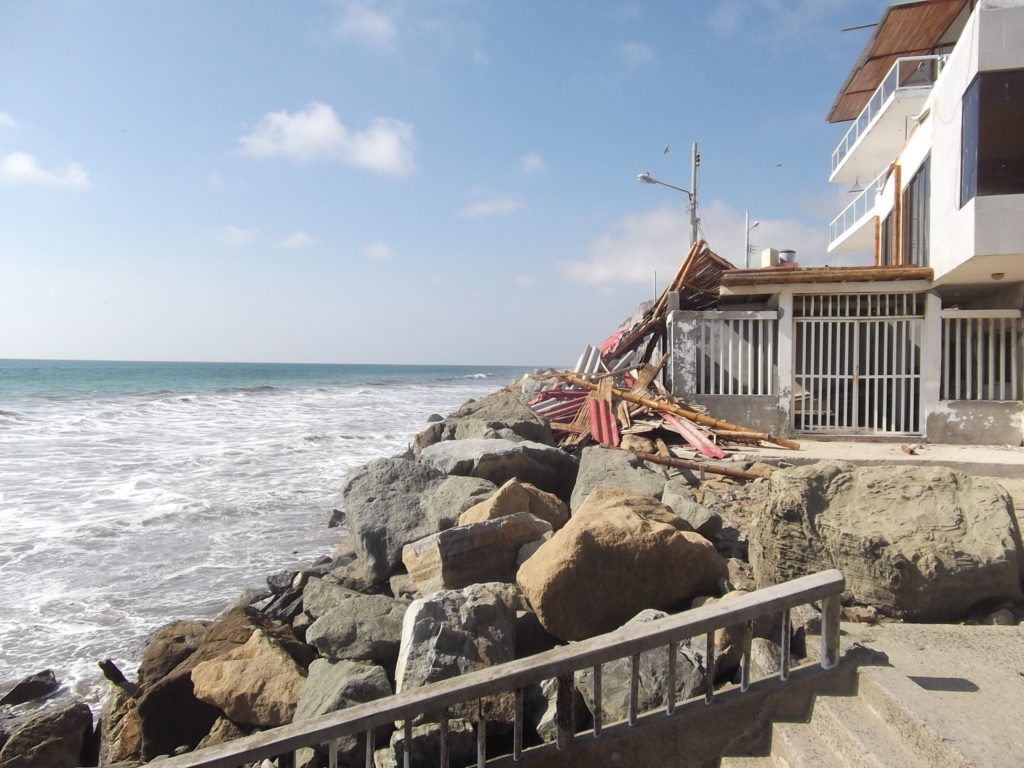
Having driven from Cuenca to Guayaquil our intention was to add additional gasoline on the coastal side of the mountains. We also needed to bolster our water supply. Gasoline stations were functioning normally where we took on an extra 20 gallons. We discovered very quickly that most supermarket shelves and stores were already without regular drinking water. And this was Guayaquil.
We arrived in the coastal town of San Clemente, some 30 minutes south of one of the most damaged towns of Bahia de Caraquez. San Clemente had suffered some damage but phone signals were good, restaurants and stores were open, using generators for power. Water and domestic gas supplies were being delivered throughout the evening. One local told us that some of the stores in town were refusing to sell goods in the fear that a food shortage would ensue. There were also reports of the water companies inflating prices. In this location no emergency services were evident and the supply of consumable goods seemed normal, although locals were reporting that there were no bus services, which we knew to be untrue. Makeshift church services were being held in the town centre where light bulbs and generators existed. A few families we encountered claimed there were food shortages and we were glad to offer what we could to help, although we found sufficient stores open and plenty of goods for sale even late into the night. Our accommodations on this evening were donated by a friend from Cuenca, whose modern apartment building with 4 floors, was showing signs of cracks but no structural damage. The town was without mains water and electricity when we left the next day.
Photo: Chris Breen, Warning tape in Bahia town centre
Bahia de Caraquez, Pop: 20,000
Bahia is located at the mouth of the River Chone Estuary on the seafront. It has suffered many quakes and rebuilding over the past century. Its main economy is shrimp farming and tourism.
After a half hour drive north to the town of Bahia is was obvious from the outskirts that we were going to face some major damage. The roads on the entry into town were twisted and buckled, smaller houses were in pieces or slanted at angles. Most perimeter garden fences made of brick were entirely destroyed. Most of the damage was caused to concrete buildings whereas older cane, bamboo or wooden houses seemed unaffected.
Photo: Chris Breen, Bahia de Caraquez, Condominium damage on seafront
Photo: Chris Breen, Bahia de Caraquez, town centre
Photo: Chris Breen, Bahia de Caraquez town centre
The damage to the entire town was catastrophic. The seafront is lined with tall apartment buildings of which most had suffered major structural damage.
The ground was still trembling and we both felt a surge of electrical energy going through our bodies.
The town was well policed by the military and police, water trucks were delivering to all neighbourhoods to a frantic line of local people in desperate need of water. Large excavating machines were already working on destroying smaller buildings and it was obvious the taller buildings were going to have to come down at sometime in the future, under controlled explosive demolition. Work was dangerous.
One of the only unscathed buildings was the new mall built by the new bridge. The food hall was open and full of people so we took the opportunity of having fast food, where emergency workers, expats and locals were trying to connect with internet Wifi. Within ten minutes we felt a tremendous after shock which cleared the mall within 30 seconds.
The new Bahia bridge to San Vincente was partly damaged within its mid sections but there are unconfirmed reports that the bridge is sinking into the bay.
Cellphone reception was good and gas stations were open.
Photo: Chris Breen, Bahia Bridge, relatively unscathed by quakes and functioning
San Vincente is on the opposite side of the bay from Bahia. Most properties and businesses suffered similar damage to Bahia.
Canoa. Pop: 7,000
A small beach-side town and well-known surf resort
The town of Canoa lies just 30 minutes up the coast from San Vincente. We had heard reports that the road to the south of Canoa was blocked due to a landslide. Helicopters were already flying the coastal route. Two days prior it was reported that a team of para-gliders from Montanita were trying to air drop supplies into town.
Some 15 minutes into the journey we came across a traffic backup.
The landslide that had blocked Canoa to emergency services was now open in both directions. Temporary work had constructed a debris filled road some 5 metres above the original road. Houses on the beach-side were damaged in the slide.
I had spent many days during the years in Canoa. The first impression was one of total shock. We parked our car in the central football field with the emergency services that were already searching for bodies or signs of life. We spent a good half hour walking the entire town. There were no visible signs of any building being untouched by the quake. Larger hotels made of concrete had sandwiched their floors. There had been no time to get out. The damage to most places looked lethal and an overwhelming stench of dead bodies lingered in the air. Most of the people we saw walking around were still in shock and wearing facemasks. Diggers were already pulling down the smaller houses whilst rescue teams were working in silence looking for signs of life or removing the dead.
Photo: Chris Breen, Landslide on Coastal Road to Canoa, now open after 3 days of closure
Canoa had changed during the years. There were plenty more buildings to serve an increasing number of tourists, mainly surfers, but now there was no more Canoa.
Hostal Bambu was still intact and being used as the nerve centre for the rescue teams. They were busy serving food. The Surf Shack bar too, although boarded up. Both businesses were made from bamboo and cane. Both survived.
Tent cities were now appearing on the outskirts of town. It felt like a nuclear bomb had gone off. It will take years to rebuild this entire town. Tourism, its principle income, will be non-existent for many years.
Photo: Chris Breen, Footbridge in Canoa next to Hostal Bambu
Photo: Chris Breen, Canoa Beachfront hotel, bunk beds lingering on the edge whilst rescue teams search the debris below for signs of life.
Photo: Chris Breen, Canoa town centre where rescue teams were already cleaning and searching debris in a wooden house.
Photo: Chris Breen, Canoa, Rescue teams search in silence for signs of life under a mangle of rebar and crushed concrete.
Puerto Matal & Jama, Pop: (Canton) 20,000
Jama is located approximately one hour north of Canoa on the main highway to Pedernales. Its sister town of Puerta Matal is a small laid back fishing village some few kilometres on the coast.
The roads to Jama were now showing some major structural damage. Small bridges had buckled and large chunks of cement had surfaced. Where straight roads once lay, the line was that of a snaking effect. Cement drainage canals were torn from the highway and most cement and wooden electrical poles were tilting towards the east. The centre line of the road was separated as much as 20cm apart and at times we were confronted with road elevations that were as much as 2 metres from one lane to the other. Emergency workers had already filled in the gaps with debris and electric companies were already working on restoring communications.
Traffic was at a standstill at the entry to town. Makeshift tents were being built along the roadside as we drove. Donation trucks were handing out basic items to anyone in need. The military were controlling the lines of people, some as many as 100 strong, in order to keep order as they filed up for water and basics. Improvised roadside stands were selling food to the passing traffic. The gas station was open and busy. Cellphone connection was clear. Military units and police were evident everywhere.
To us, Jama looked like the Epicentre of the entire disaster.
Photo: Chris Breen, Jama, Improvised tent accommodations on the main highway take advantage of passing relief trucks entering the town.
Toward the town entrance is the local market hall. Trucks from all parts of the country were lined up and a team of military and police were unloading goods inside. The rear, outside walls of the centre were lined with coffins to accommodate a death count that was rising
by the hour.
Photo: Chris Breen, Jama town centre totally destroyed.
Similar to Bahia and Canoa the devastation in Jama was flabbergasting. We talked to a local in the street with some soldiers listening in. He was from Portoviejo, another city with major damage. He claimed 60 people died in one hotel that he knew of in his hometown.
There was a much bigger military and police presence here. Most of the homeless were again on the edge of town, busy constructing temporary shelter. Damaged homes and businesses were left to rest, mattresses and cooking pots, broken furniture and child dolls hanging in the debris. Here the death count must have been higher. The town square was no longer square. Not one tarmac or cement road was straight. Cracks in the roads were as wide as 50cm and deep. Sidewalks were turned almost upside down. The spaghetti mix of flying cables merged with the tangled rebar sticking out from all corners. Digging machines were struggling to clear the damage. This was now a ghost town.
Photo: Chris Breen, Jama, Daylight breaks through a ‘hammered’ church. What was the Word of God trying to preach to these poor people?
Photo: Chris Breen. Jama town centre
From Jama we decided to travel due west to the small fishing village of Puerto Matal. This was a journey of around 5km. Roads were damaged and the river running parallel to the road was swamped with fallen trees. Papaya trees growing in the adjacent fields had just snapped with the weight of their fruits.
Photo: Chris Breen, Destroyed House of Pablo & Marcela
Irregular terraced sections of broken land lined the entire route. Before arriving at Matal we suddenly stopped by the river to see two people clearing the debris from their destroyed home.
The owners introduced themselves as Pablo and Marcela. They had been working since the previous Sunday to retrieve whatever they could of personal property. Michael and I had seen some devastation but this was heartbreaking. We offered help, which they accepted. We spent ten minutes unloading the car of pick axes, spades, hammers and other tools that we thought could help. Michael was ready to go, sporting his hardhat and gloves. Pablo suddenly asked what we wanted to do.
I told him we were ready at his command to do whatever they needed. We were finally ready to settle in and get our hands dirty. The heat was oppressive.
Pablo says, “ We have done as much as we can so far. We were told by the authorities that if we need to claim any kind of government assistance we need to leave the place as it is right now. We fear if we do more, then we will get no money from the government”.
Michael and I were surprised. But under the circumstances we could not force our help on them. Thinking about what Pablo said there was a logical explanation for what he told us. Many Ecuadorian homes are in a state of constant building, stage by stage. It would be difficult to assess damage if everything was cleared by the owner. We parted with donations of water, food and cash and moved on to Matal.
I’d spent my 50th birthday in this small beach hamlet. Wonderful seafood, happy people and a pleasant beach. In the years after, development was rife on the north side of the village catering to a wealthier clientèle. The fishing village was destroyed. The new developments had suffered selective destruction, as if the builders had different codes in each location.
Photo: Chris Breen, Puerto Matal, New housing destroyed close to the beach
There were perhaps 20 or 30 newly built properties on the north side of Puerto Matal in a gated community. At least 50% of these had suffered severe damage.
We decided it was time to continue the trip and head north through Pedernales.
Pedernales. Pop 20,000
This town had been the total focus of the media in the days prior to our arrival. I’d watched 2 hours of live broadcast the evening before our departure. It was rumored that the highest death toll would be in this town. There were reports that on the seafront alone, some 30 hotels had collapsed with their guests inside. The local mayor was begging for outside help.
Photo: Chris Breen, Tears at Epicentre , JCB digger (built in my own hometown) helps with the rescue.
We were nervous on entering the city itself. There were some verified reports that the city was in practical anarchy and that relief donations and cars were being robbed before they entered the city.
We decided to by-pass Pedernales. At this point we were struggling with a stalling car and still fully loaded with donations. Our route north took us through the centre of town, which was totally devastated.
Photo: Chris Breen, Pedernales
The death toll in this city is most likely going to be the highest. Aid in the city was at a peak when we arrived. Gas stations were open, cellphone service was working and the town (by day) did not seem to have a threatening environment.
We were more than curious to venture even further north into the province of Esmeraldes. There was little, if not, no news from this area. The very epicentre of the quake was due north of us in the coastal town of Muisne. The town of Mompiche was some 2 hours in the same direction and was our destination for our second night.
Arriving in Mompiche we were surprised to see a small town with electricity. Our arrival time was just after dark and the lights could be seen well above the town from the nearby hills. This is another small town famous for its surfing and tourism on a small scale.
Most of the hotels were closed at 7pm and reluctant to accept guests. Restaurants had already retired for the evening or not even bothered to open. Stores were closed. The town was in bed early. So close to the epicentre and yet we got the feeling that there was little damage.
Photo: Chris Breen, Bamboo and Cane structures mostly survived
The following morning we did a small inspection of the town. Little damage was evident other than straw ceilings collapsing and minor cracks in concrete bases. We moved on to Muisne, another hour north of Mompiche.
At this point we had discovered a few things. There was no sign of aid being delivered to any of these towns. There was little damage. The roads were intact, electric supply was in place, but intermittent, which is not unusual for these remoter destinations. Cellphone service was good and life seemed to be undisturbed.
Muisne is one of the most northwestern towns on the coast of Ecuador. This was the exact epicentre of the quake that struck the previous Saturday evening. From the main highway to the town (a distance of more than 10km) there was evidence of makeshift villages but a clear lack of destruction to support it.
We arrived in the centre of Muisne where it was evident that some minor damage had occurred but nothing on the same level as other seaside towns. Gas stations were open, businesses were functioning, cellphone service was working and plenty of relief teams were on hand. Although we saw little destruction in the main part of town we have seen more recent photos and reports of the fishing village which show a good number of houses levelled.
We continued our trip north to Atacames and Esmeraldes where it was evident that little to no damage could be seen.
Observations from the journey
• Impressive relief effort from national resources in the way of water supply and emergency ambulance services serving remote locations.
• Many helicopters serving coastal towns
• Coordinated donation services controlled and sometimes filmed by police
• Some trucks issuing donations roadside before trying to reach donation centres, resulting in mob scenes when not controlled by police or army
• Heavy presence of military guarding most seriously affected areas
• An impressive endurance of the new coastal roads and bridges
• Abundant gas stations open throughout the coast
• Cellphone service in most disaster areas
• Phone and electrical companies servicing the entire route
• Many people in need of food and water but not clothing
• Makeshift tent villages being the forefront of attention
• Sufficient heavy equipment to start the clean up effort
• Local, national and international aid already working
• Lack of generators in most areas without electricity
• Lack of storage space for personal goods retrieved from damaged homes
• Oppressive heat and no rain
• Few visible injuries and well attended medical services
• Fast clearance of landslides and filling of holes in roads
• Major damage to street lighting, water mains supplies and effluent systems
• Major displacement of affected families to tent villages
• Lack of materials to build temporary accommodations
• Hoarding of donations by people with sufficient supplies
• Rumors of price gauging
• Relative normality as you get closer to the epicentre
• A lack of effort toward cleanup work by locals
• A sense of calm anywhere away from donation centres or trucks
• A lack of national or international press services
• No cold storage due to electrical damage
• Lack of awareness by locals that more aid is on its way
• Years of aid needed
Suggestions for Recovery
As I was compiling this report I came across the following comments made on Facebook today. Author undisclosed. (April 25, 2016).
I had to sit and think for a while.
“This goes beyond petty theft to downright despicable. I finally got through to Dave today. He and Brendan are on their property in Canoa. It is largely untouched. In fact it is one of the few places in Canoa left standing so the relief workers have been using it as a staging area.
He said most of the Ecuadorians are just sitting around on their asses partying. He said it’s mostly extranjeros doing the digging and trying to help people. Most of the Ecuadorians don’t want to lift a finger to help dig people out or help in any way for that matter. A drug dealer there told him business has never been so good. All people want to do is party.
HE and Brendan are okay, but maybe not for long.
They have been told that all of the relief supplies arriving in Canoa are for Ecuadorians, not extranjeros. They will not give food nor water to any foreigner in Canoa, only Ecuadorians. In Canoa that is a death sentence”
“Giving Back”
We are all affected by opinion, fears and gossip. I was taught at an early age that “Charity begins at home”. For our entire expat community living in Ecuador this IS our new home. We can choose to stay and ignore the situation in the hope that things will resolve themselves, we can genuinely contribute or we can simply pack up and leave.
Having spent the best part of 14 years in Ecuador I would like to reveal some more personal observations and make suggestions on how we can contribute. I for one, am here to stay.
Quite often I hear the statement that its time to “Give Back”. I’m a firm believer in this statement but I also feel that people need to dig a little deeper into the reasons for their outpouring of generosity. Would it not be true to state that in order to give back you would need to have taken something in the first place? Exactly what have you taken? Exactly what are your intentions. Do you want to volunteer your time, your money or simply your sympathy and good intentions? All of them count!
Michael and I travelled these disaster areas for 4 days. We were well equipped for the emergencies that we might encounter and had sufficient supplies on board to make the smallest of contributions that we could, with donated goods and cash from friends. However, we were not prepared for the shear magnitude of the devastation. I think we can say we saw more devastation than most in the different areas that we covered.
Knowing Ecuador and its citizens I can never quite get over the juxtaposition of its immense beauty and the ugliness of the towns and villages in the land. The Incas certainly scarred many people but they built palaces and beautiful gardens. Today fortresses and palaces have given way to barbed wire fences and cement blocks. There are endless reasons for all of this, buts its an image that never goes away. For those of living in our dream world we rarely entertain these thoughts. In fact you would have to have traveled extensively in Ecuador to see the full picture.
Ecuadorians can be nice. Don’t get me wrong. But a good sense of humour and friendly attitude often contrasts to a lack of pride, lazy lifestyle and habitual lies. It’s an accepted part of life here and many people understand what I’m talking about. Even the locals laugh at themselves for the very same reasons.
Ecuador has been served its due share of disasters over the years and they are quite prepared to accept anything that comes their way in the form of aid. Over the years I’ve met numerous Peace Corps volunteers frustrated at the lack of involvement in the areas they are trying to improve.
“ It’s all good and dandy while we are here, but when the program stops its life back to normal”, said one volunteer. “They can’t wait until we leave!
It is way too easy to judge and generalize on these personal perspectives, but as a business owner for all my years in Ecuador I’ve come to the conclusion that nothing should come for free. Do our best in the short term to relieve suffering, but have a master plan when it comes to charitable donations for the unforeseeable distant future. But don’t just give it away!
Where is my money going? Can I trust them?
With one firm signature, Bill Gates could resolve our problems with a single check. But Bill is not knocking on the door yet. If I was donating my millions I’d want to have my charity do the following.
Gain the trust of your contributors.
Be totally transparent.
Use donations without the need of middlemen.
Put their name on something they can see.
Create a crowdfunding platform to raise money on the internet.
Have a master plan.
Choose a specific location where donations can make an impact.
Keep it small and confined.
Plan a short term relief effort with long term goals
Keep them updated on developments.
Have qualified and experienced disaster relief experts coordinating efforts.
Have a paid and qualified Ecuadorian manager on the ground at all times.
Use other volunteer organizations to bring in specialists from around the world.
Use volunteer groups to staff and help reconstruction.
Bring the community in at all levels of development.
Choose safe and tested materials for construction, sourced locally.
Explore the idea of building a community with bamboo and cane
Have an onsite office.
Create schooling that educates and involves children in the development.
Teach locals new crafts that they can use, sell or trade.
Provide micro loans to set up small businesses.
Explore the idea of eco tourism where volunteers can come and help.
Buy a new boat and teach them to fish.
Create self sustaining farming practices and permaculture.
Bring in new energy platforms like solar power and wind generation.
Provide security for the community.
Teach basic medical classes.
Set up a community barter system.
Estimate and commit to a time period for completion.
Work with other charities to make the dream come true.
Items urgently needed
Smaller items
It was obvious that the immediate concern was for temporary shelter. Most donation areas within Ecuador were busy bringing in food, water, clothing and medical supplies. What they overlooked were the immediate requirements to build temporary homes. These items include but not limited to are the following:
Plastic sheeting in rolls used for roofing
Zinc roof top pieces from 2.4m length to 5m
Synthetic materials in rolls for sidewalls
Spades, pick axes, hammers of all sizes, nails, screws, screwdrivers, saws
Angle grinders and disks for cutting rebar
Wooden columns to build tents (mostly available locally in the form of cane)
Mosquito netting in rolls
Small mattresses for children (not the oversize donated ones which limit space)
Cooking pots and utensils
Small shelf top gas stoves with from 1 to 4 burners
Empty water containers from one gallon size upwards
Plastic bowls for washing plates and clothing
Rope and washing lines
Plastic chairs and tables
Family medication supplies box
Water purification tablets
Larger Items
20 foot shipping containers that secure valuable rescued items
Generators and electric cable
Community water tanks from 500L to 2000L
Emergency shelter systems
Compost toilet systems
Solar lighting systems
Links to companies providing emergency shelter systems
http://inhabitat.com/8-innovative-emergency-shelter-designs-for-when-disaster-hits/bamboohuts534/

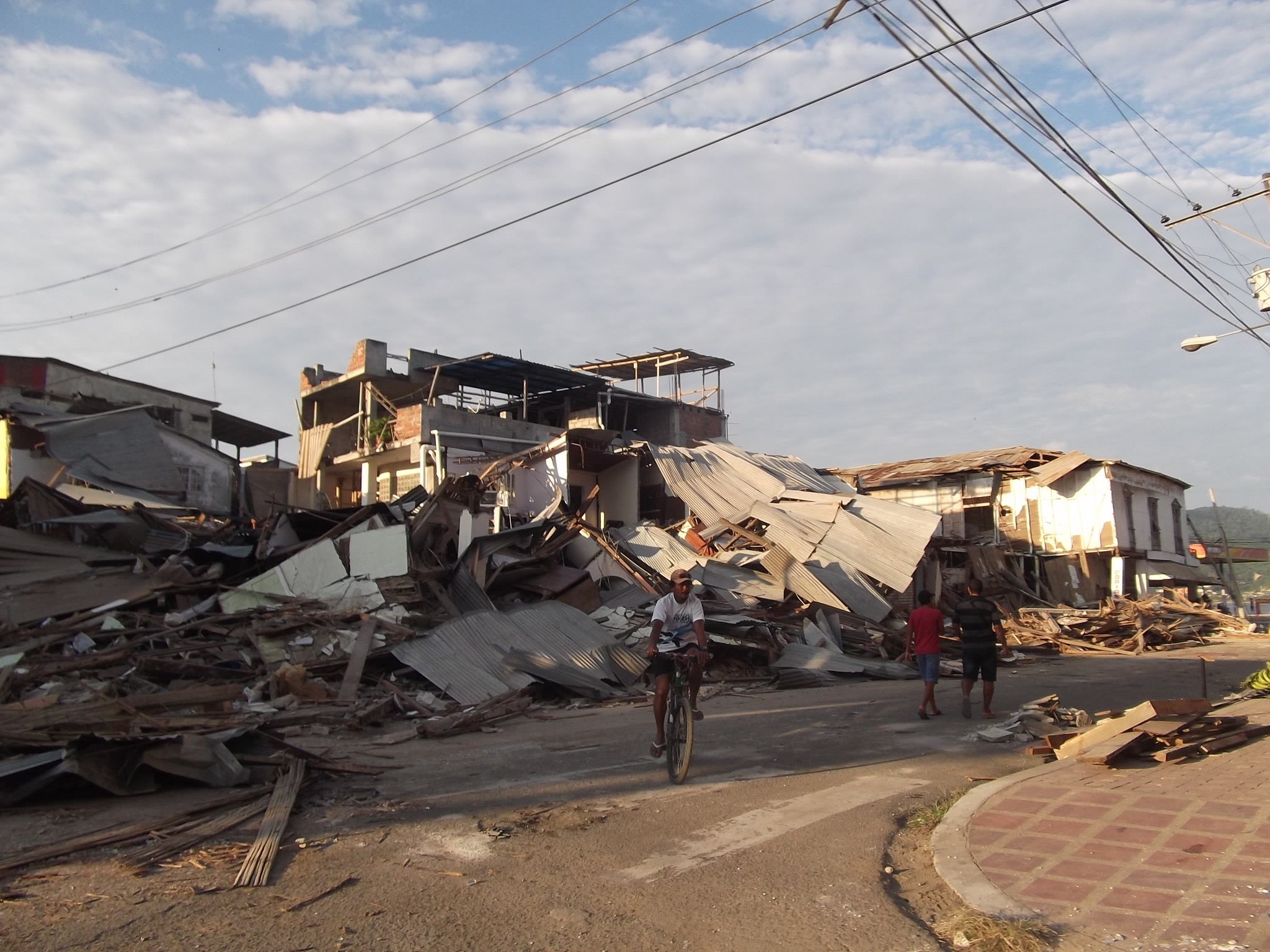


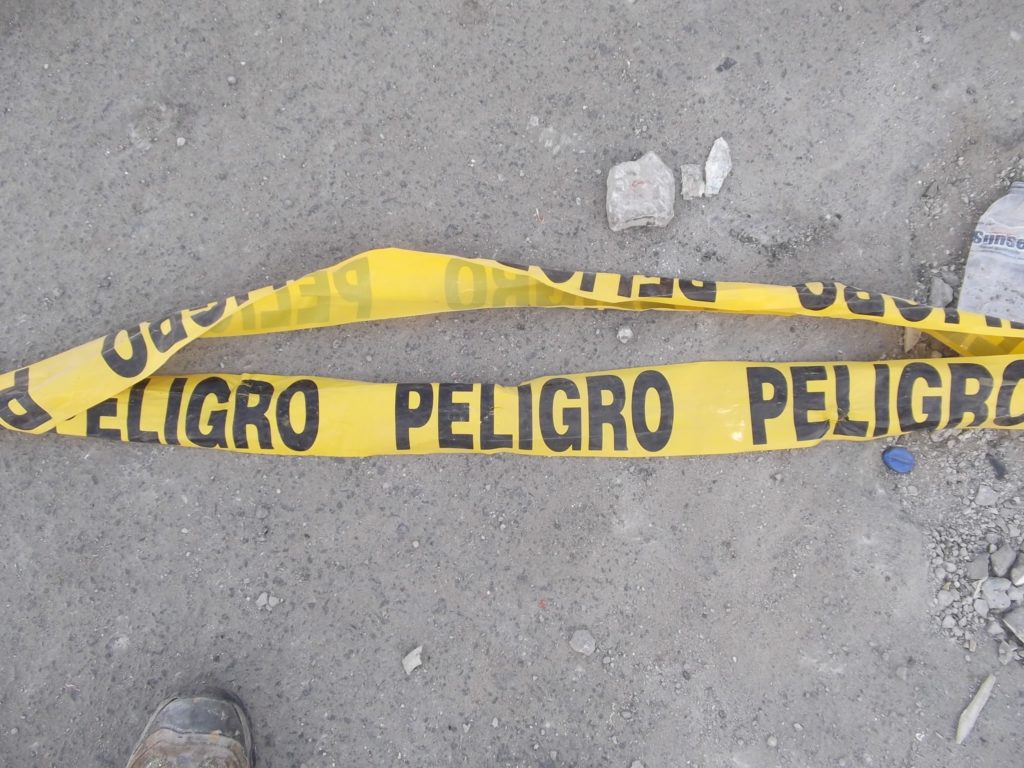
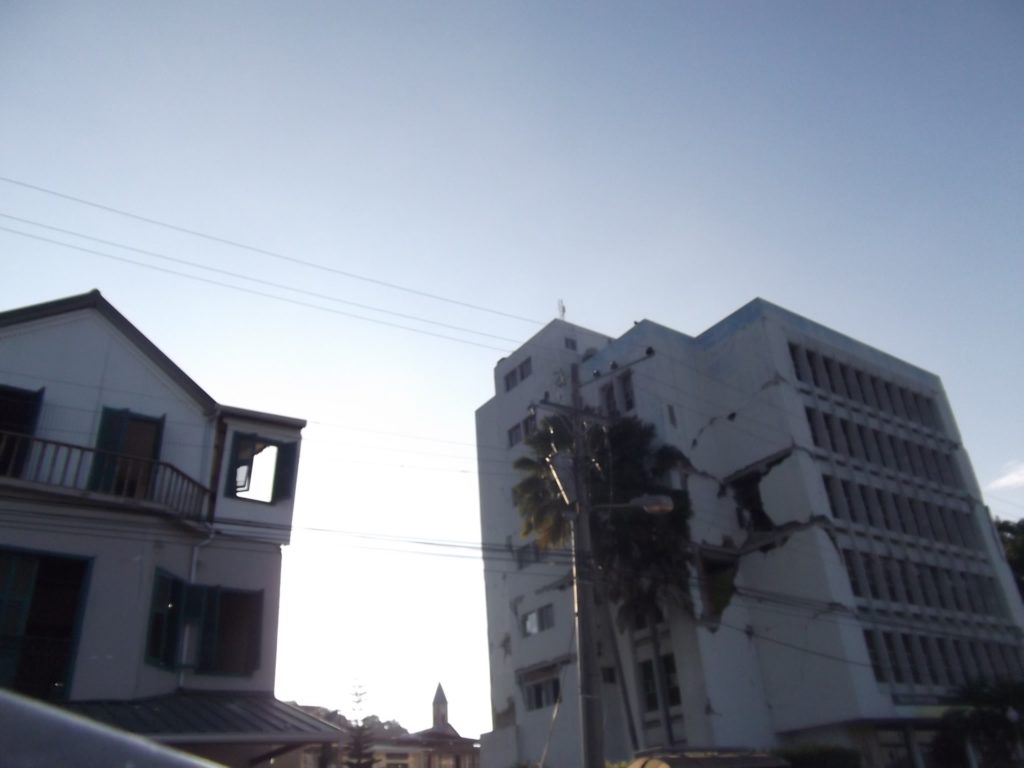
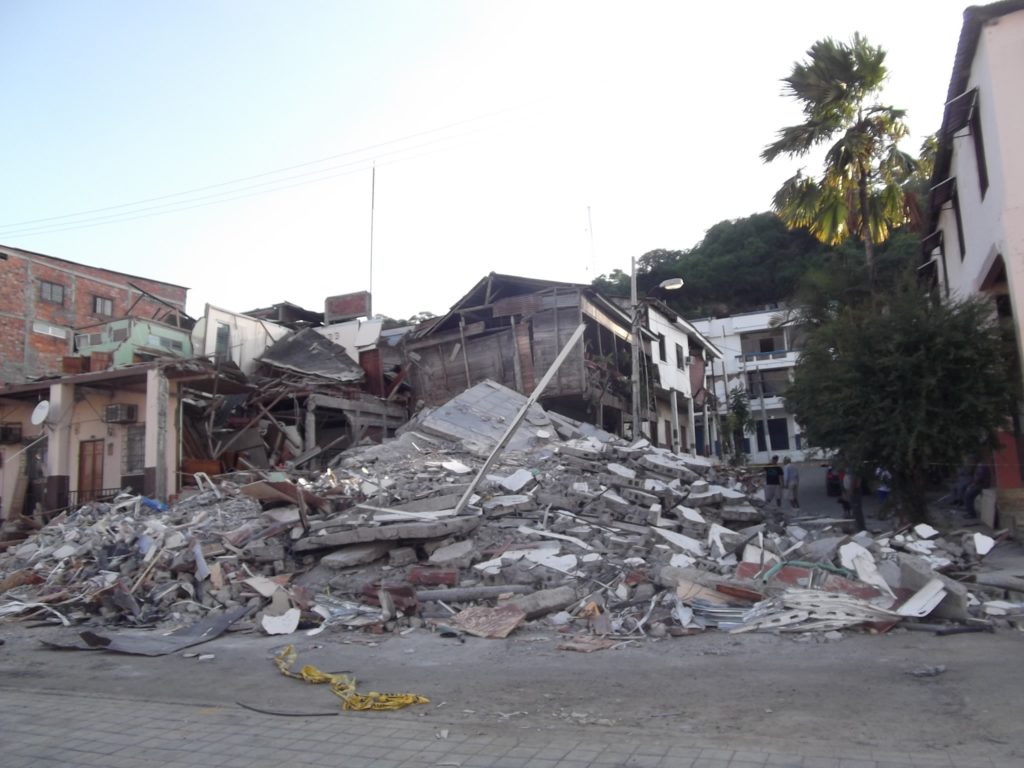
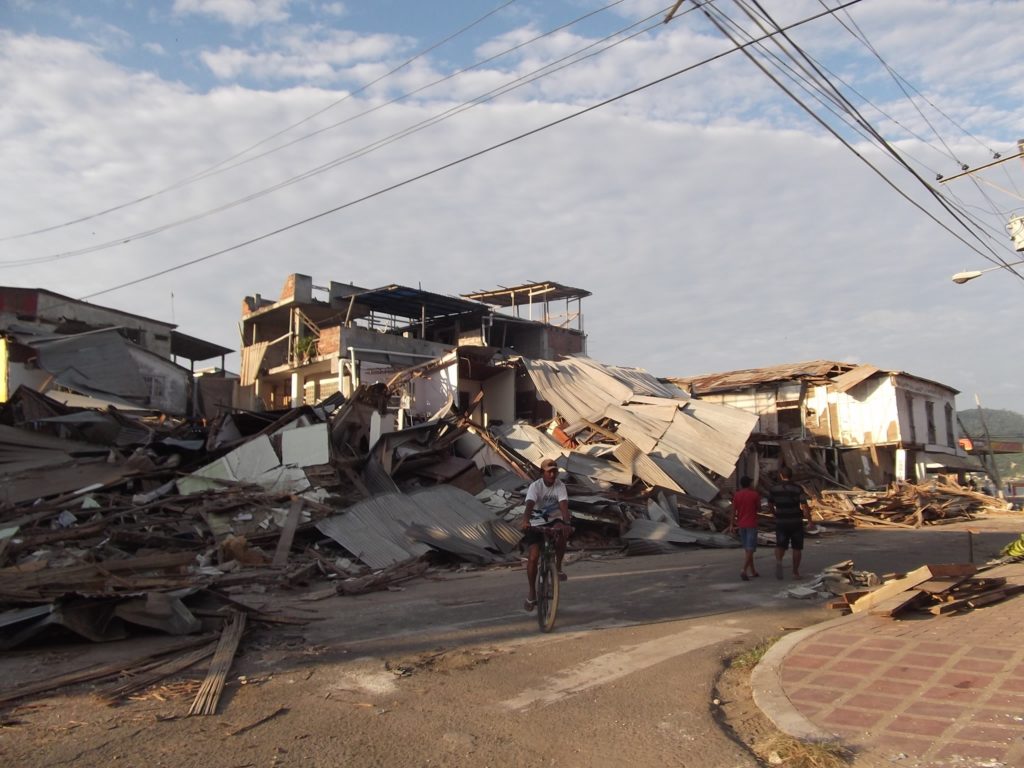

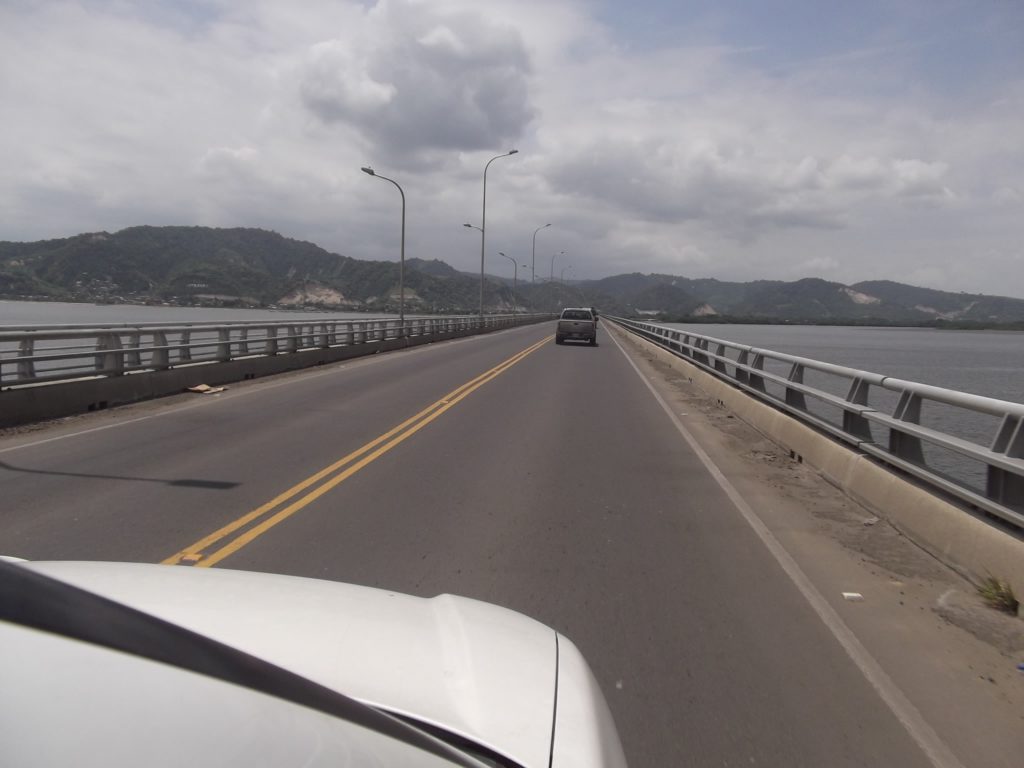
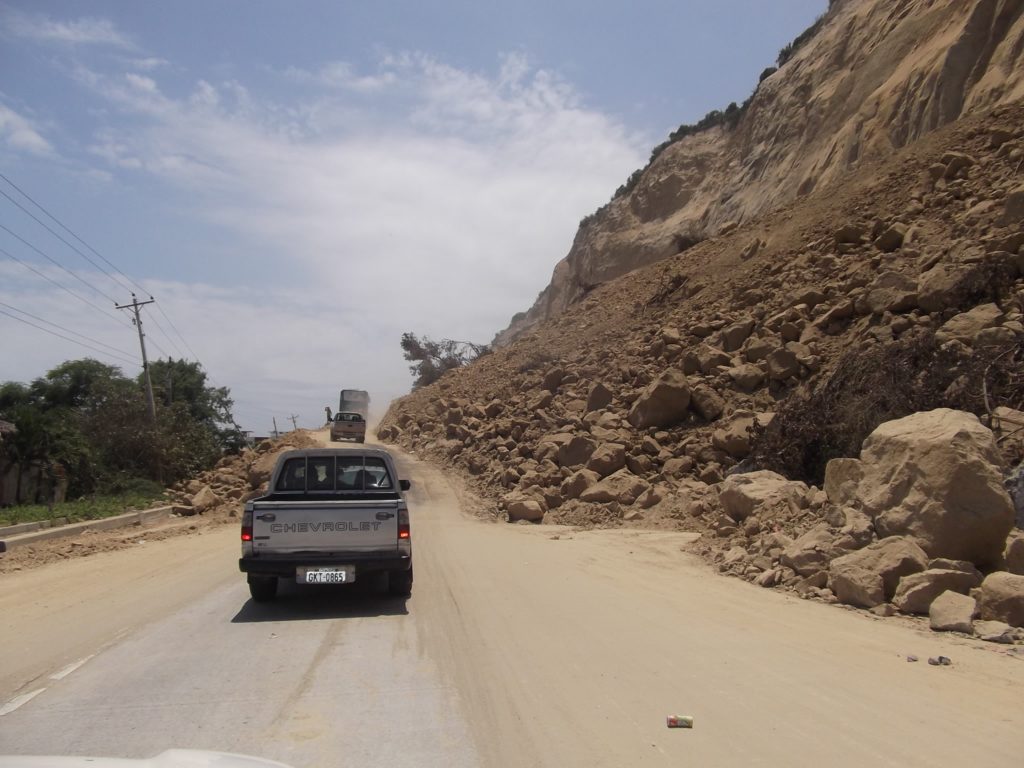
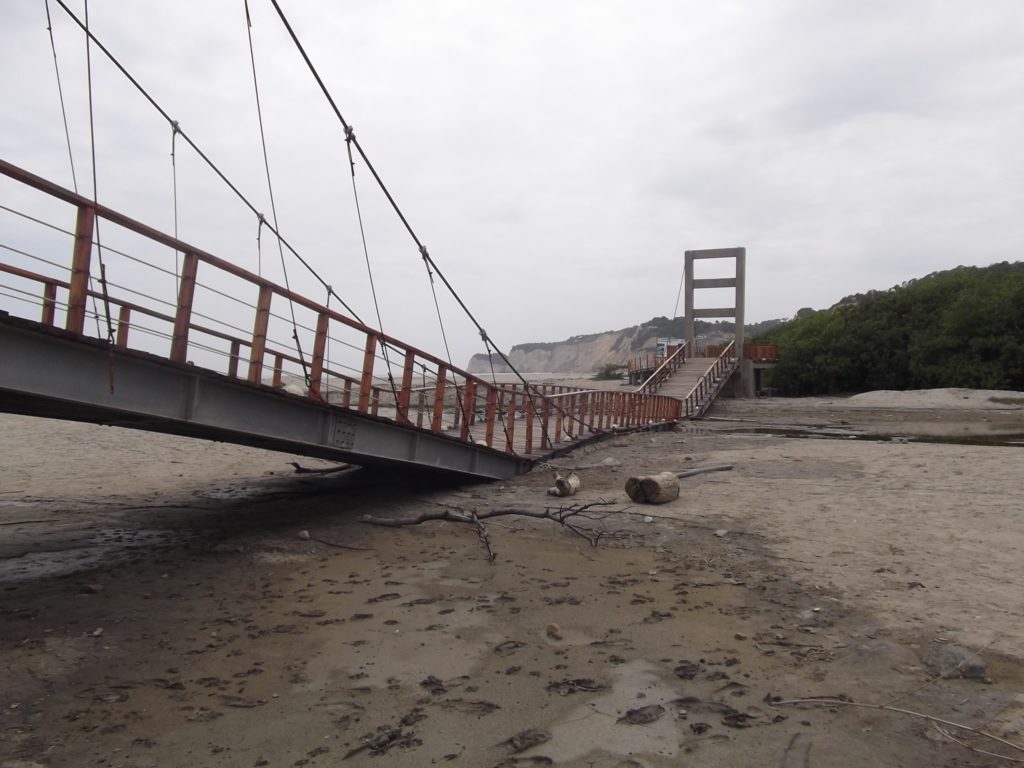
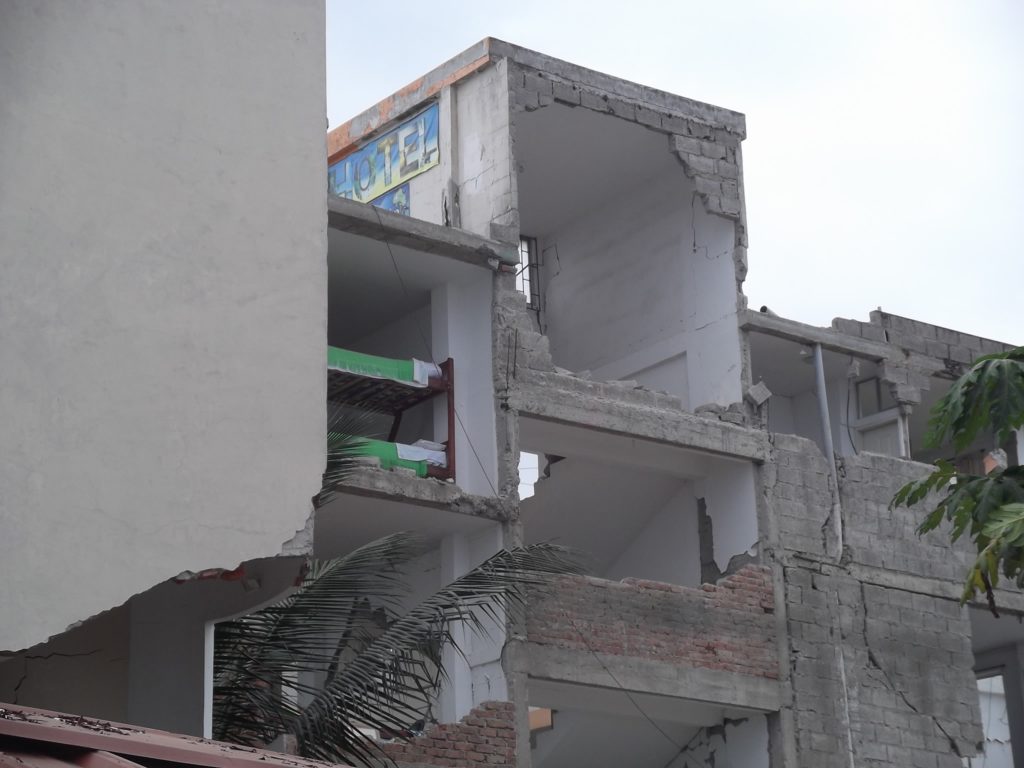
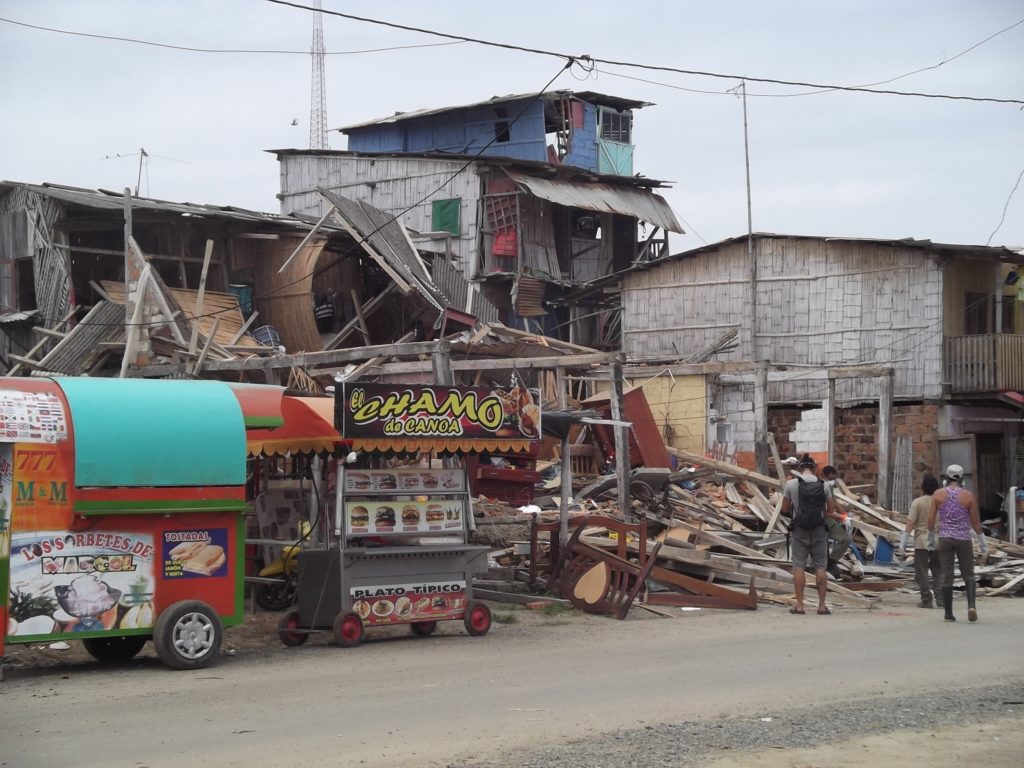
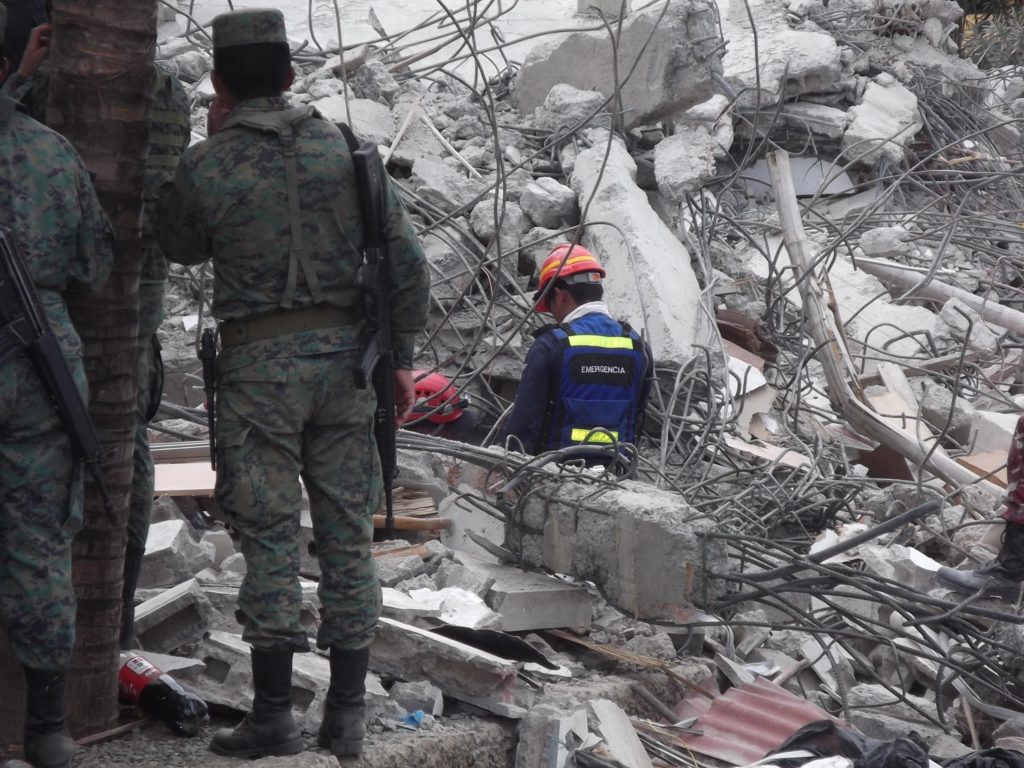
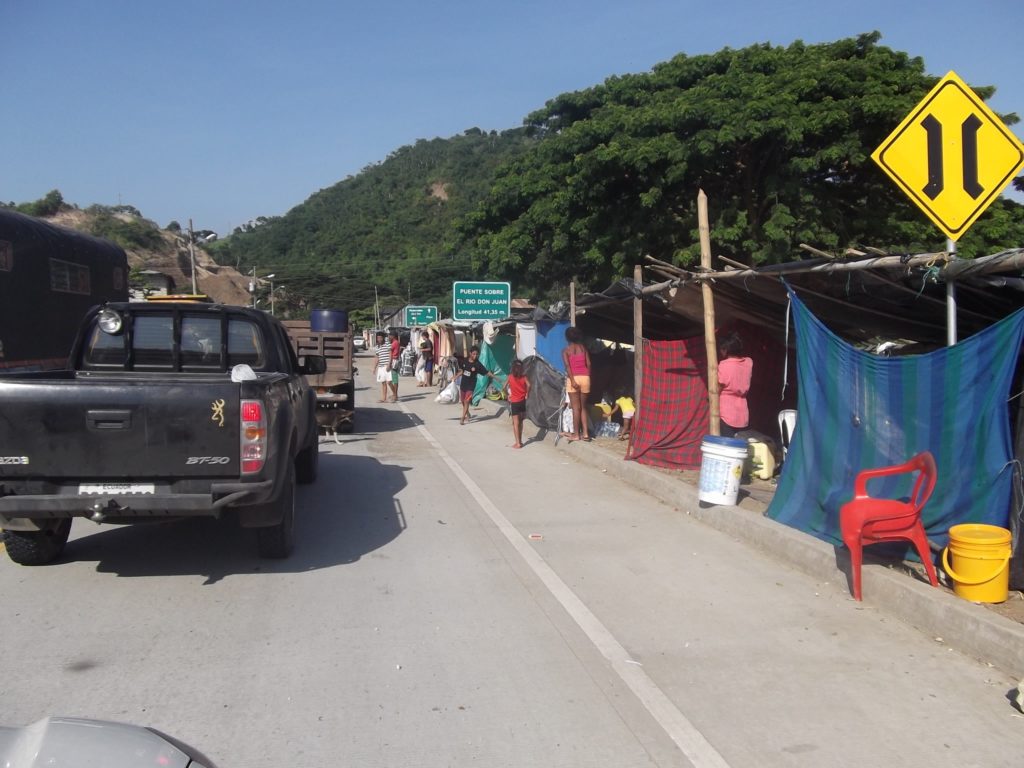
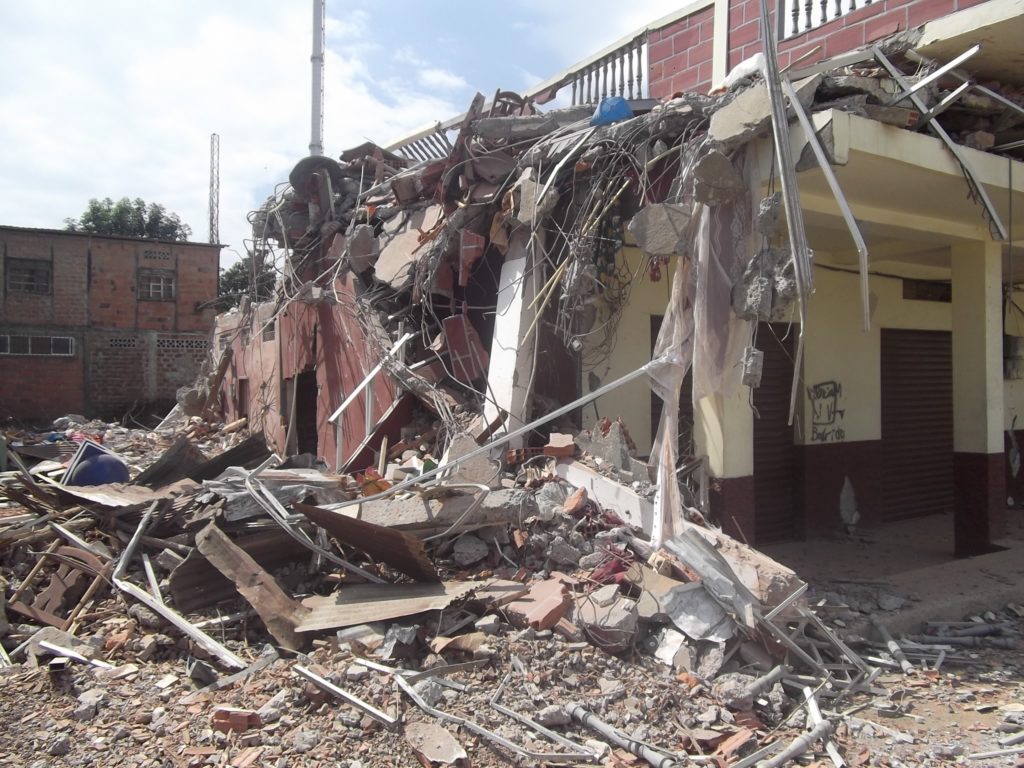
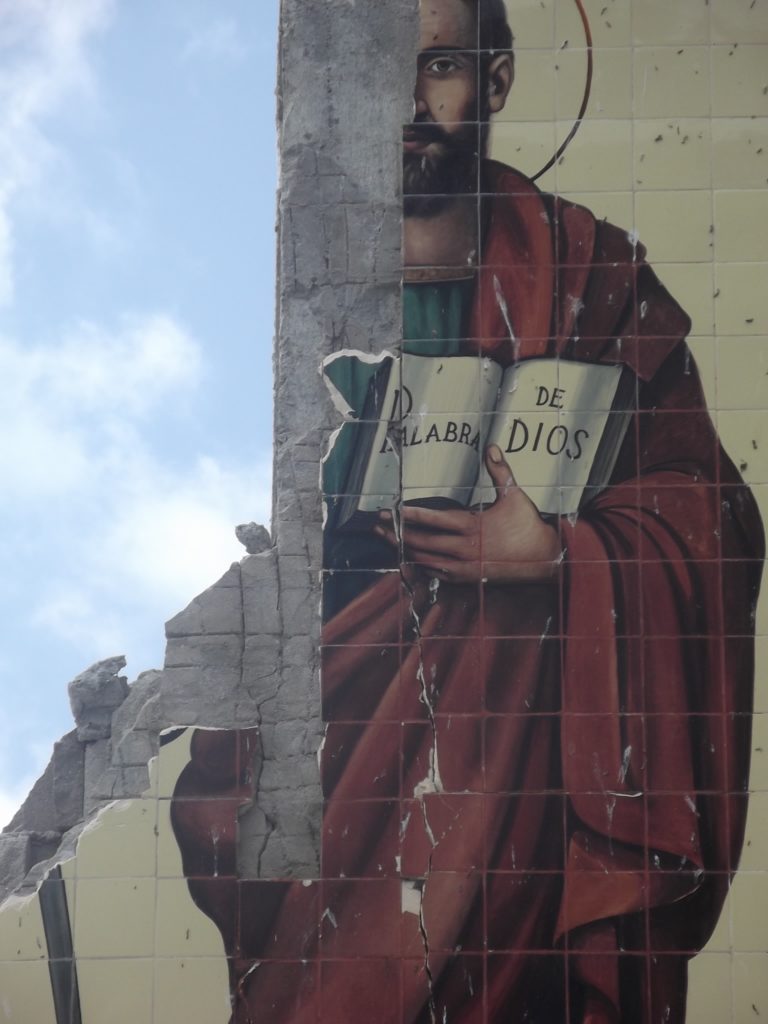
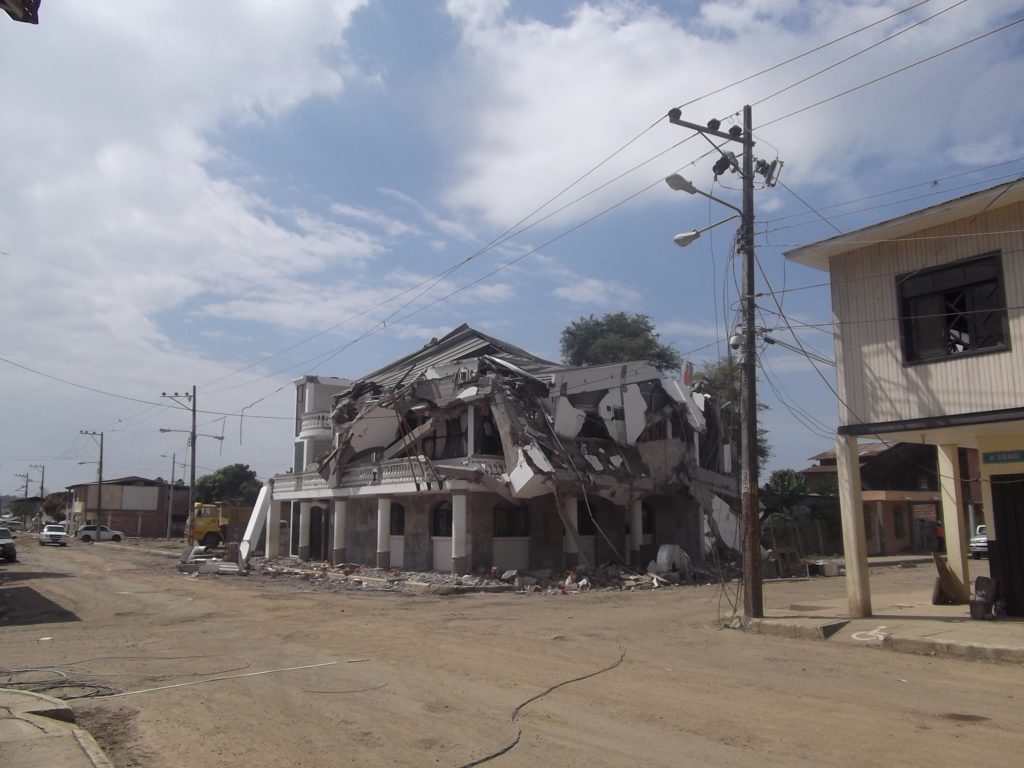
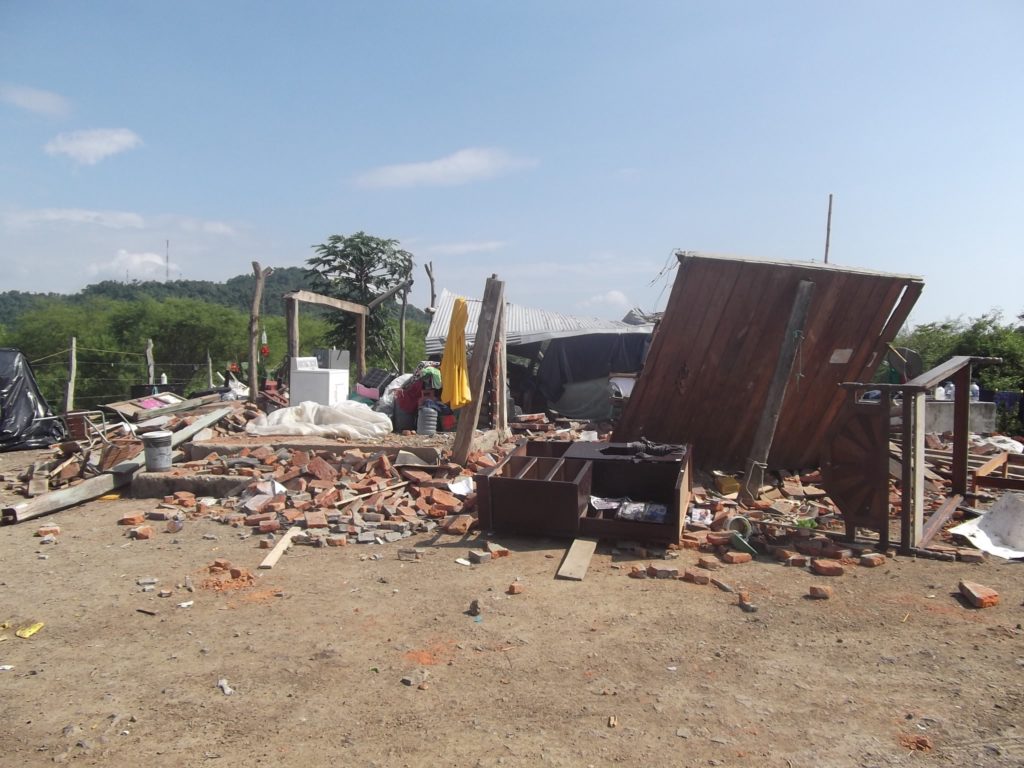
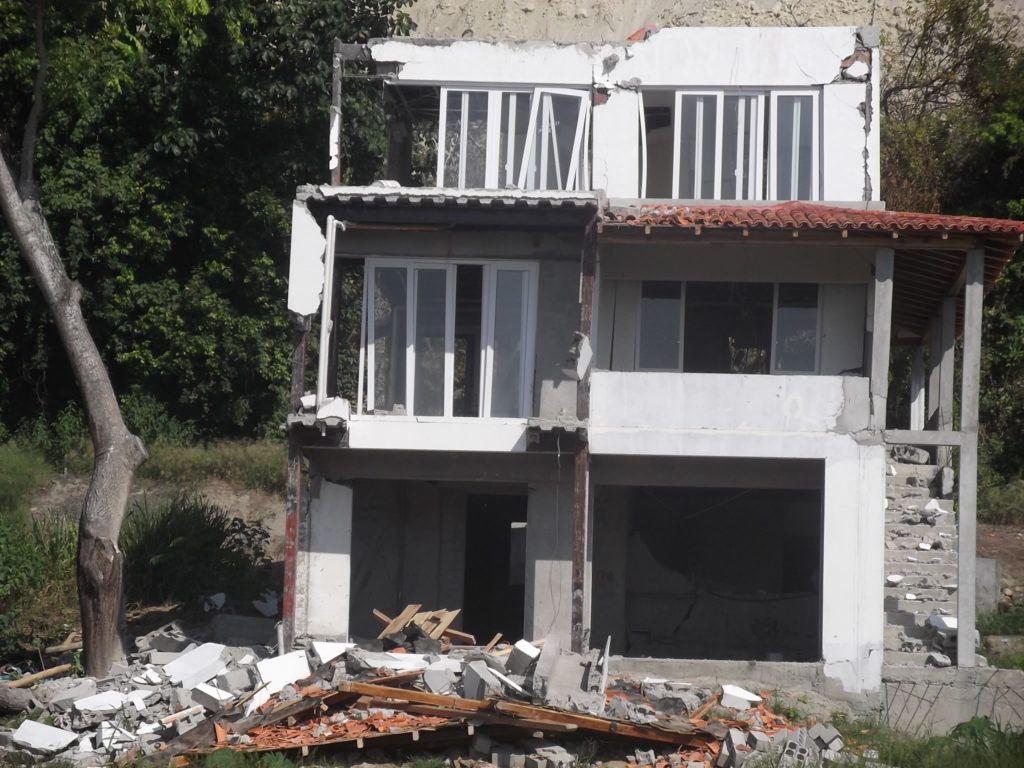
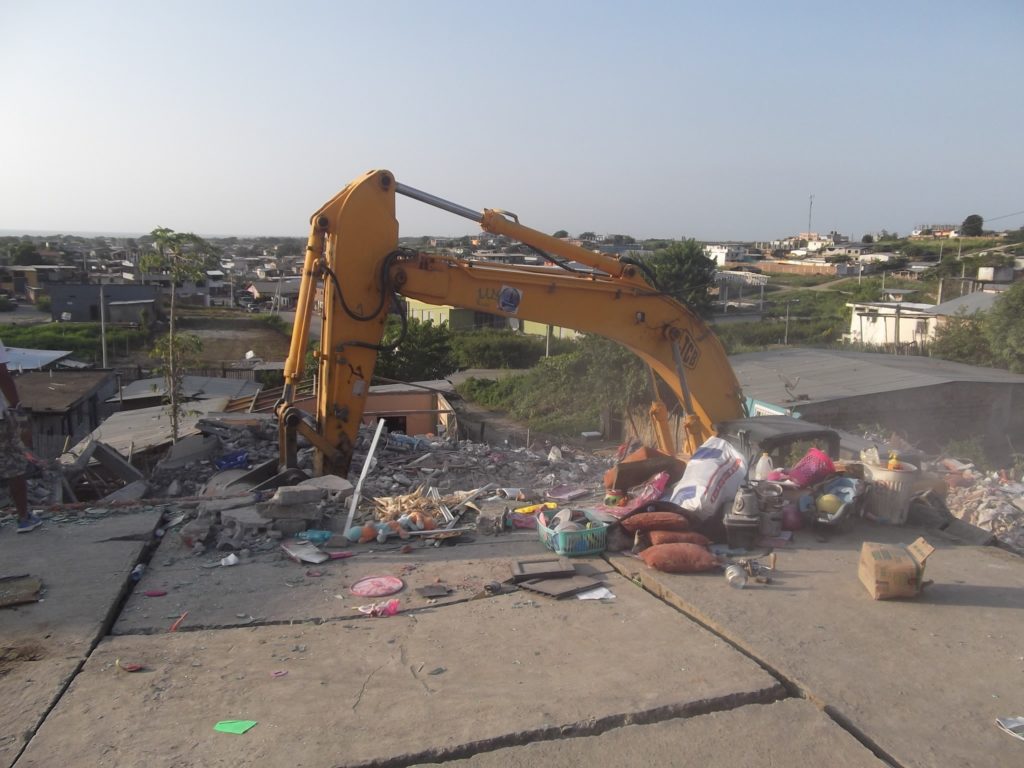
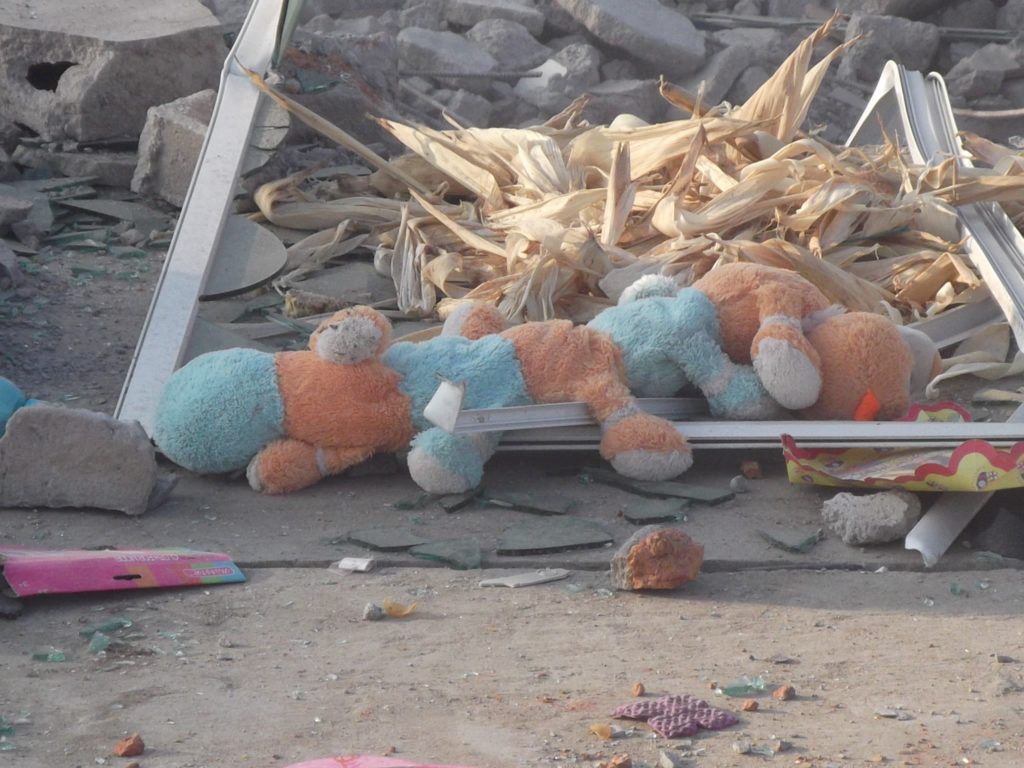
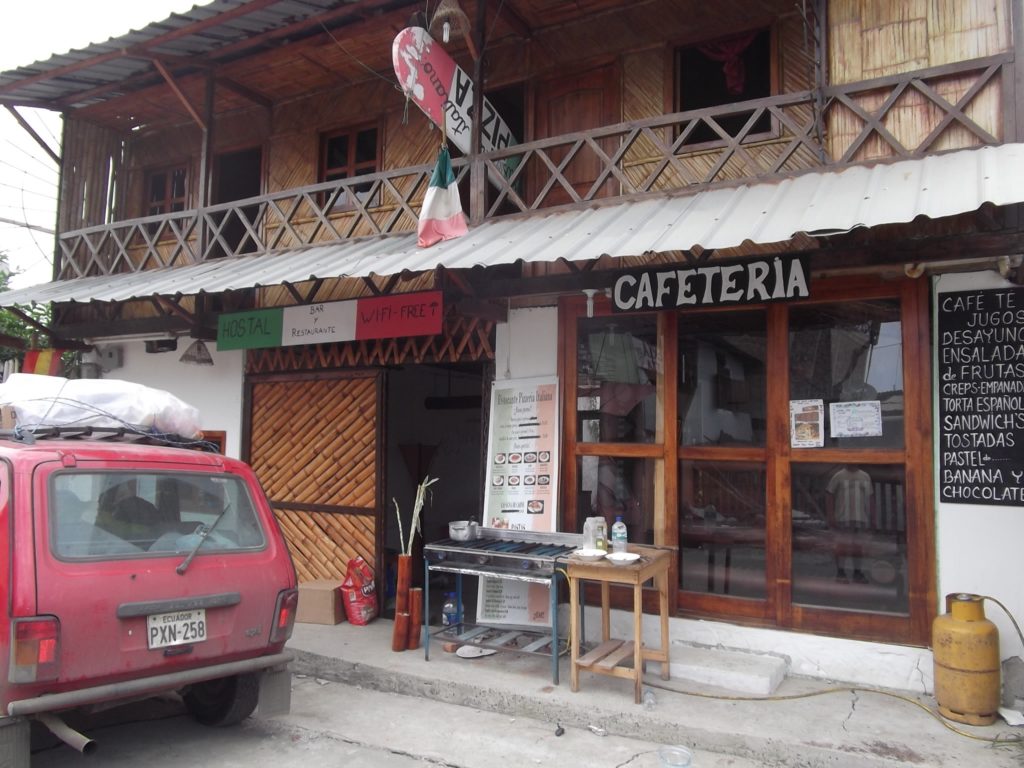


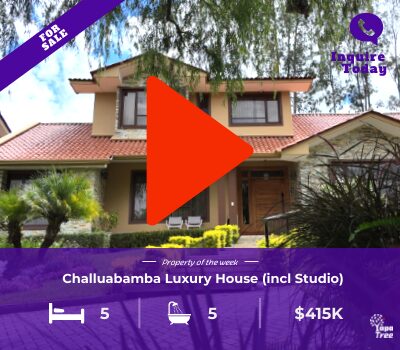



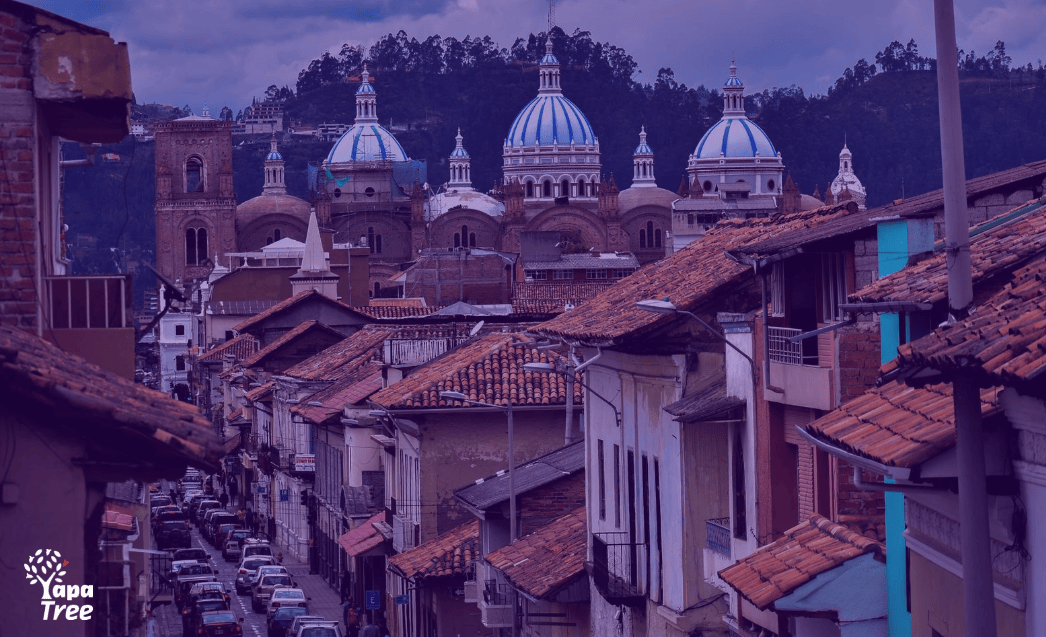
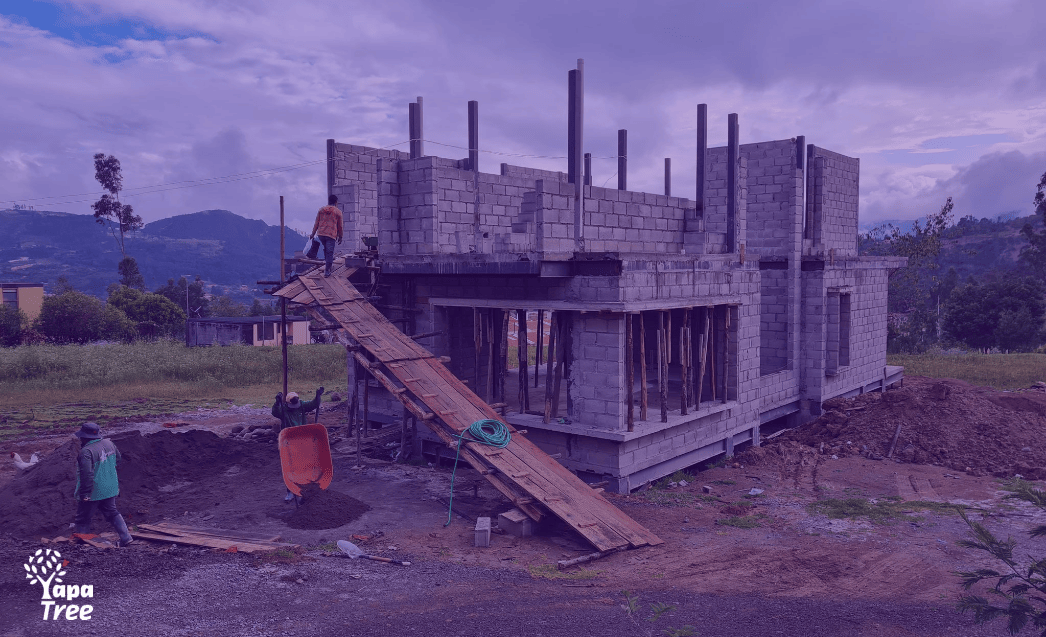

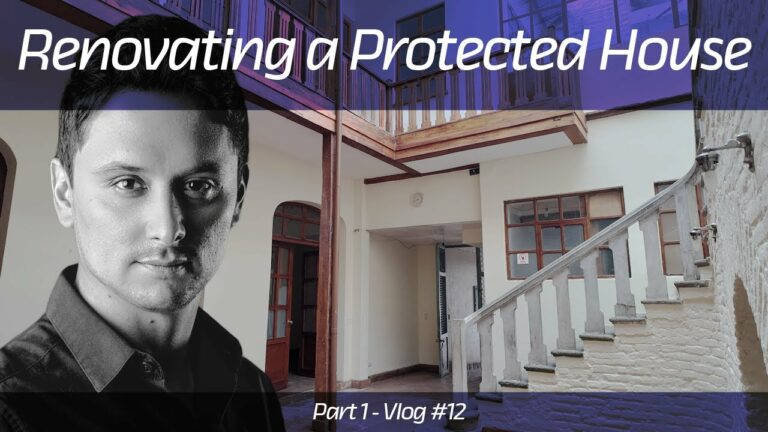

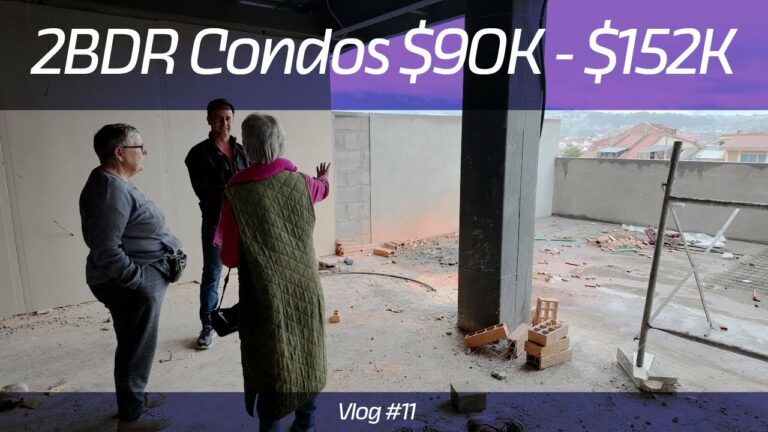

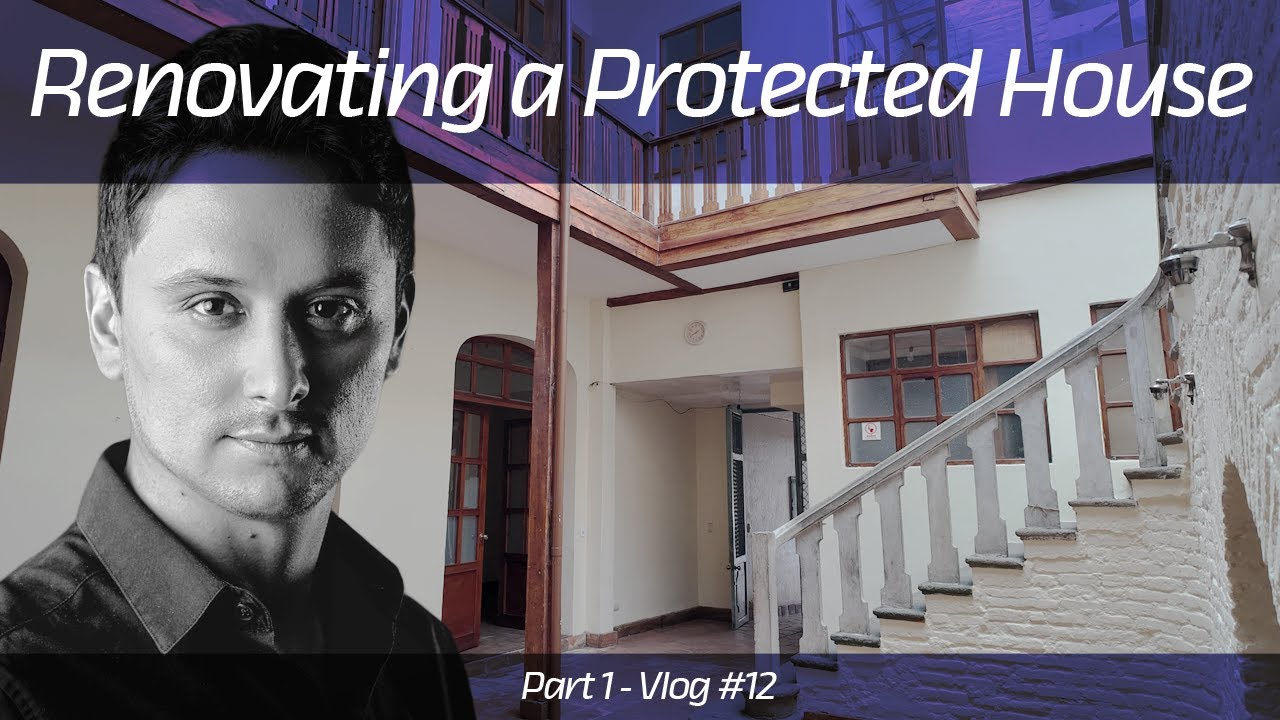

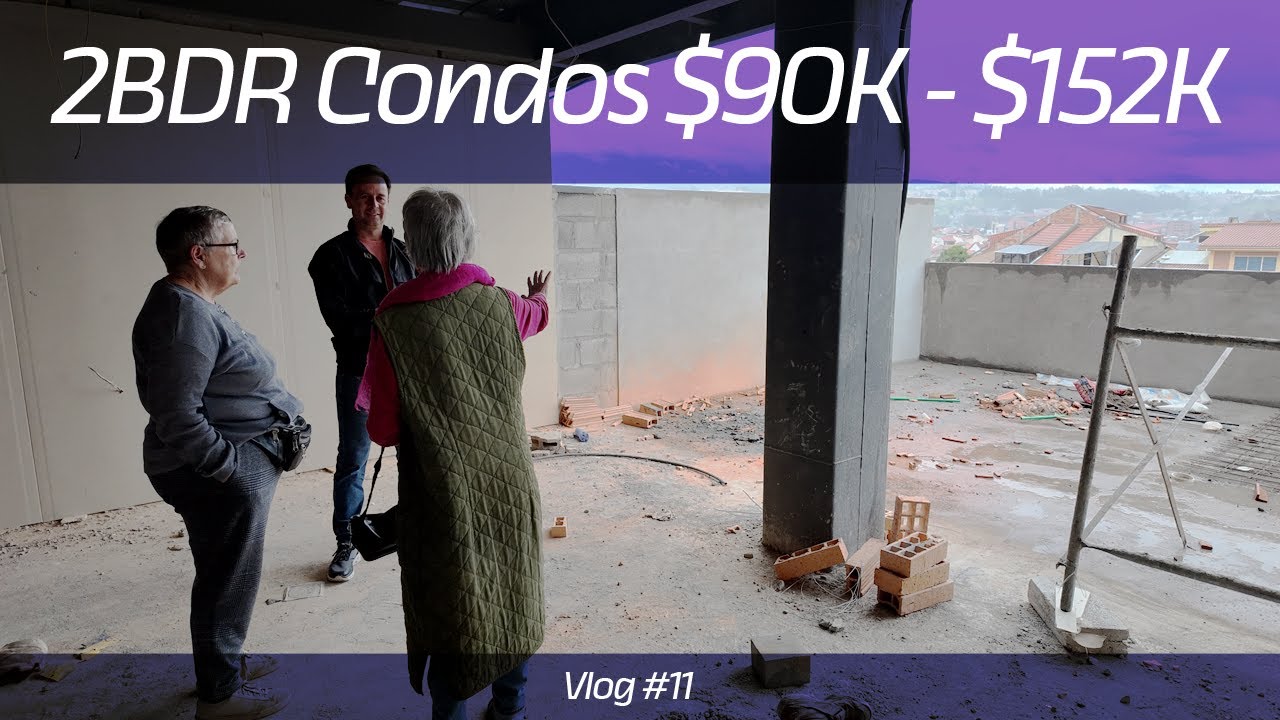
6 Responses
That is not a sea front hotel in San Clemente. The hotel is behind the camera. What you are looking at are the remains of a beautiful balcony that overlooked the ocean and now it is on the ground. I know this because we had rented that house to move in on April 25th. We stood in that house, loved it and imagined ourselves on that balcony watching the sunset daily and now we can’t help to think that if the earthquake would have happened 2 weeks later all my family would have been in that rubble.
Thank you for your report. It does give us a clearer understanding of how to help them, and how to choose a project. And you’re so right on the Ecuadorian culture, lovely people but it’s not always easy to work with them. My husband went today to Pedernales, but now he’s stuck at La Concordia 🙁 Geetings from Riobamba!
Thank you for the info, it was very helpful.
It is strange that you guys did not see any news coveraqge on site, we were bombarded with news on every channel on tv and radio. Every eye is trained to see diferently I guess. I even saw reporters from Colombia, Venezuela, Bolivia, Perú, CNN was here, to name a few.
You see, this has been a disaster for us, ALL of us who live here in Ecuador. 9-11 tore two buildings down, we have at least three cities destroyed and the whole country is on the move trying to help any way we can. There have been hundreds, hundreds of trucks sent with donations to the affected zones. I see lines of people waiting just to be accepted as volunteers here in Guayaquil. All that help that our fellow friends from the sea side área have recieved fo far, has been given with all the love we have for them.
Ecuador has united as one nation, and I´m proud to see that, I am proud to be an Ecuadorian. But you see, my pride, Ecuadorian pride, just like everybody else, has to have a limit, and there´s where we may have definition discrepancies: we are not “over-proud”, we don´t think we are “the best nation in the world”, there´s no such thing, it would be idiotic to think that way, but hey, to each their own.
My wife and I were watching tv and we saw a guy going over all the debris were his house once stood, he was desperate; and across the Street there was a group of people standing there watching, just watching without lending a helping hand. Weird, very weird, BUT, that´s something cultural that I think you fail to see:
We have three “zones” geographically and culturally speaking. Mountain áreas are much more cooperative than the coastal people. Those Little diferences make us…diferent, that´s all. But you are failing to give a full repport including the whole movilization from all branches and stratta of our society. So many examples of people pressumed death and found alive, rescuers and unprepared but willing volunteers working endless hours just to help. That is something you HAD TO point out in all fairness.
You also depict us almost as pathological liars, damn man!. Well, again, perhaps that´s the kind of people you are attracting, in any case as usual all we have to do is look into a mirror and problema solved.
Look, I know you mean well, but since you write on a web page on the internet, the you are subject to critic. And I also mean well, I just think this report was incomplete. See, this is the difference between well organized, unbiased journalism and a guy writing on the internet. Of course, I´m yet to find well organized, unbiased journalism at least here in Ecuador.
Oh, and something else. About the donations, it is a shame but the government has overtaken all the operations and they apparently think they need to take credit for every action Ecuador as a whole has made. We have a corrupt government, no different from the ones before. There, I said it. And so should you, you say you´ve been living here for 16 years? you´re one of us, you´ve earned it.
My name is Pablo, I´m the taxi driver who Works as a handler in Guayaquil. I´m sure many people know me. Cheers and God Bless.
P.S. Just be kind about my broken english, cause we ARE about your spanish 🙂
We were very blessed in San Clemente with lesser damage than other villages on the coast. You did a great job on your report and thank you for helping out so many people. I would like to add my personal comments on our observations : There was more destruction than what has been stated, mainly newer buildings, no electricity for 6 days. We were very blessed. From day one all worked together , especially the Ecuadorians , to start repairing and rebuilding. The people here in our village do not lack pride, do not have a lazy lifestyle and are not habitual liars. This isn’t a way of life here in San Clemente. Sometimes their prideful nature can make it difficult to help or work with them. Feel sorry others have that opinion of the people here just on the actions of a few. Been living here 4 1/2 years and know the people well. Viva Ecuador!
Thank you Chris, for your tremendous photos and your personal account and opinions. The photo entitled “Photo: Chris Breen, Bahia de Caraquez, Condominium damage on seafront”, that building was actually the MUSEUM filled with amazing artifacts Incan, and also much beautiful local art, many floors. Not sure the damage inside, praying it is minimal, but it is a national treasure house. Very sad it was so damaged. Also, we have been in Ecuador for over 4 yrs and have not had the same experience as you regarding the Ecuadorian people. The MAJORITY of the people we have associated with, and this has been a LOT, in Bahia de Caraquez, Manta, Puerto Cayo, and Bricenos, have been hard working, honest and not lazy at all, very willing to help out with anything we needed. Yes, the culture is to say YES, not NO to a request, but that is not a lie, it’s simply cultural. We have always treated the Ecuadorian people with respect and dignity they deserve, and have been given the same back by them. We are saddened by the devastation, and as you commented, we have to take care of the short term needs yet focus on the long term goals of rebuilding the country, physically and psychologically. There are many orphan children who in an instant, have had their parents, their homes and their surrounded taken from them, all in piles of rubble, as well as adults who have had their families perish. God bless those people as their lives will never be the same. Hopefully whatever relief they can get, and getting back working to build the country, earning money, they will regain their sense of normalcy.
Thank you to most foreigners for helping Ecuador and talking good about it s people .
I don t think people of the coast is lazy or don t want to help , the shock they suffered had them mentaly destroyed .